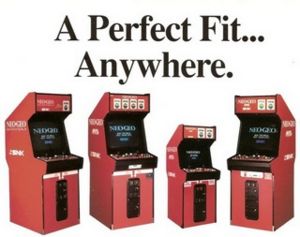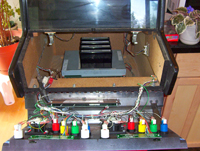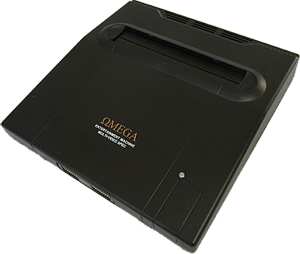Neo Geo MVS Arcade System
The MVS (Multi Video System), as the Neo Geo was known to the coin-op industry, offered arcade operators the ability to put up to 6 different arcade titles into a single cabinet, a key economic consideration for operators with limited floorspace. With its games stored on self-contained cartridges, a game-cabinet could be exchanged for a different game-title by swapping the game's ROM-cartridge and cabinet artwork. Several popular franchise-series, including Fatal Fury, The King of Fighters, Metal Slug and Samurai Shodown, were released for the platform.
History
During 1988 SNK began toying with the idea of a modular cabinet for arcades; up to that point, arcade cabinets typically contained only a single game. When an arcade operator wanted to switch or replace that game, they would have to completely remove the internals of the existing cabinet or exchange the entire setup for another game. SNK's new system, called Neo-Geo MVS (short for Multi-Video System), featured multiple games in a single cabinet and used a cartridge-based storage mechanism. The system debuted in 1990 and could contain one, two, four, or six separate games in a single cabinet. In order to swap in a new game, all the operator had to do was remove one cartridge and exchange it for another. The MVS was an immediate success. Arcade operators loved it because the setup time required for each game was nearly nonexistent, the floor space required was minimal, and the cost outlay for new cartridges was barely $500—less than half of what a traditional arcade unit cost at the time.
Specifications
Processor
* Main processor: Motorola 68000, often produced by another manufacturer, running at 12 MHz * Co-processor: Zilog Z80 running at 4 MHz. This is also used as an audio controller.
Memory
* Main memory (used directly by 68000): 64 KB
* Main video memory : 84 KB
o Video memory: 64 KB (32 KB x2)
o Palette memory : 16 KB (8 KB x 2)
o Fast video RAM : 4 KB (2 KB x 2)
* Sound memory (used directly by Z80): 2 KB
Display
* Display resolution: 320×224 (many games only used the centermost 304 pixels) * Color palette: 65,536 (16-bit) (Not RGB565, but RGB666, where the lowest bit of each channel is shared with one bit) * Maximum colors on screen: 4,096 (12-bit) * Maximum sprites on screen: 381 * Minimum sprite size: 1×2 * Maximum sprite size: 16×512 * Maximum sprites per scanline: 96 * Background layers: 0 * Aspect ratio: 4:3 * A/V output: RGB (through JAMMA connector).
Sound
* Sound chip: Yamaha YM2610 * 4 FM channels, 4 operators per channel * 3 SSG channels * 1 Noise channel * 7 ADPCM channels * Work RAM (sound): 2KB * Sound ROM 128KB on-board (only less than 32KB used) * up to 512KB sound ROM on cartridges
Power
* Source: 5v for game, 12v for sound * Consumption: 1-Slot boards on average use 5v @ 2-3a and 12v @ 1a. Multi-slot boards consume more 5v amps.
Dimensions
* PCB: Completely dependent on the board model. They come in all shapes and sizes.
Other
* Removable memory card: 2KB or 68-pin JEIDA ver. 3 spec memory
o Any 68-pin memory that fits the JEIDA ver. 3 spec will work
* Neo Geo MVS cartridge: 116-pin per PCB (Count pins on cartridge on image above if you doubt)
o Cartridge is composed of 2 PCBs
Collecting
Loose Arcade cartridges
MVS cartridges were initially designed for arcade use, but over the years a strong market has developed around collecting this particular format.
For those interested primarily in lower prices on rare home games, MVS carts, particularly loose carts or incomplete kits, can offer a cost effective alternative. Most MVS cartridges cost substantially less than their home counterparts. This lower price can be associated with their lack of decoration as most were designed to be installed inside arcade cabinets and lack cartridge artwork or box artwork, the high set-up cost of purchasing the MVS system, and the prevalence of bootleg cartridges. Many of the most common MVS games go for prices between $10–$150.
Complete Kits
In recent years a growing market has emerged for complete MVS arcade kits. These consist of all the materials that would be initially sent to an arcade operator, including the brown cardboard shipping box (with label), the insert materials to decorate the marqee and arcade cabinet (including separate move lists), warning information, dipswitch settings, in some cases even posters and/or any packing materials. Because many of the items in an MVS kit were designed to be discarded by arcade operators, finding complete arcade kits can be difficult and thus the prices for some complete MVS kits can be quite high.
Bootlegs
Counterfeit or bootleg software is regarded in the collectors community as having zero value or very low value. Such software has a reputation for audio and video flaws, and is generally disparaged by fans of the Neo Geo systems. This software is identifiable by visual inspection of the game PCBs, or by comparison of ROM CRC values using a specially designed BIOS.
Within the MVS collector's market, bootlegs are commonly found and can sometimes be mistaken for legit copies, or intentionally used to scam people into thinking they are legit. However, unlike modern conversions in the home cart market, bootlegs are very rarely near-identical to their authentic counterparts. If opened, bootlegs are tend to have one or more easily identifiable flaws that separate them from legit copies.
Modding
A popular facet of the MVS that has grown over the years, even surpassing that of the Neo Geo NGH/AES system, is the practice of modding MVS hardware. Virtually all of the mainstay mods enhance or replace certain original functions of the MVS. Mods to plain MVS boards (for use in cabinets) are not numerous, such mods include:
- Universe BIOS (replacing the original stock BIOS)
- Overclock (uncommonly performed, tends to cause incompatibility with certain titles)
Consolization
Above all, the most popular modification available to MVS, is consolization. The term describes the process of installing several individual mods into an MVS board that convert it into a home console. Possible mods and features of an Consolized MVS include:
- S-Video
- Component Video
- Stereo Sound (some MVS boards don't easily output stereo and require a modification)
- Universe BIOS
- Controller ports
- Power jack (usually for a 5 volt AC adapter, in conjunction with a 5v only mod)
- Power LED
- Custom PCB shell (or sometimes the board's original shell is used)
In recent time, high end CMVS units have become increasingly popular. Two very notable examples include the Analogue Interactive Wooden CMVS and the Omega CMVS.

Other noteworthy CMVS modders include:
- Xian Xi (frequents Neo-Geo.com and operates Jamma Nation X)
- SuperGoose
- kpj (operates Neotropolis)



